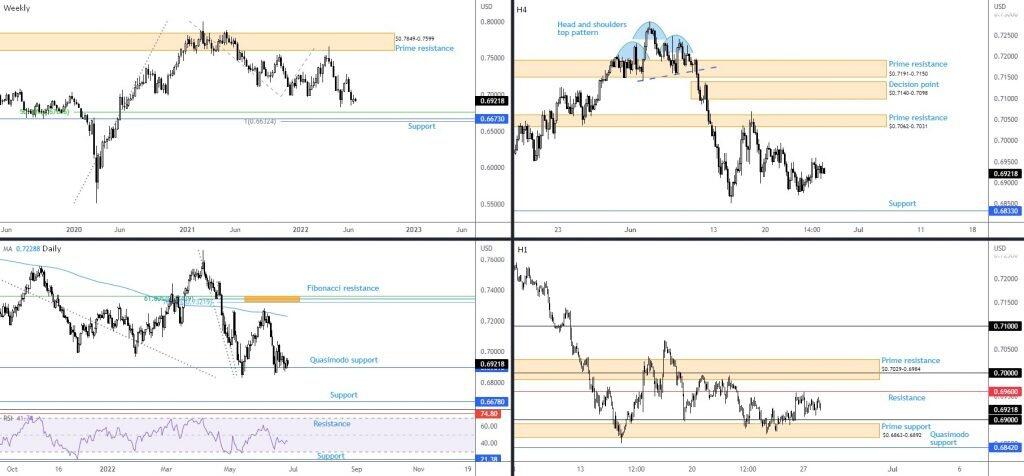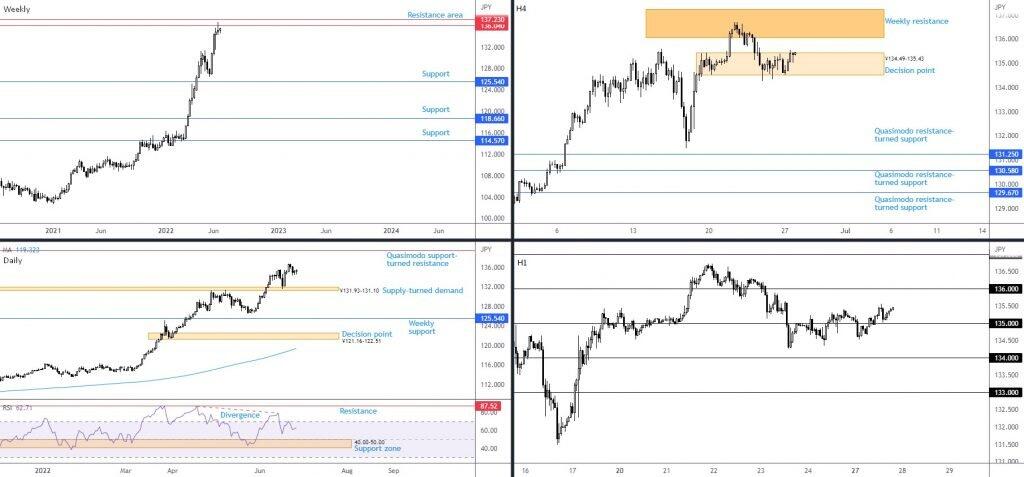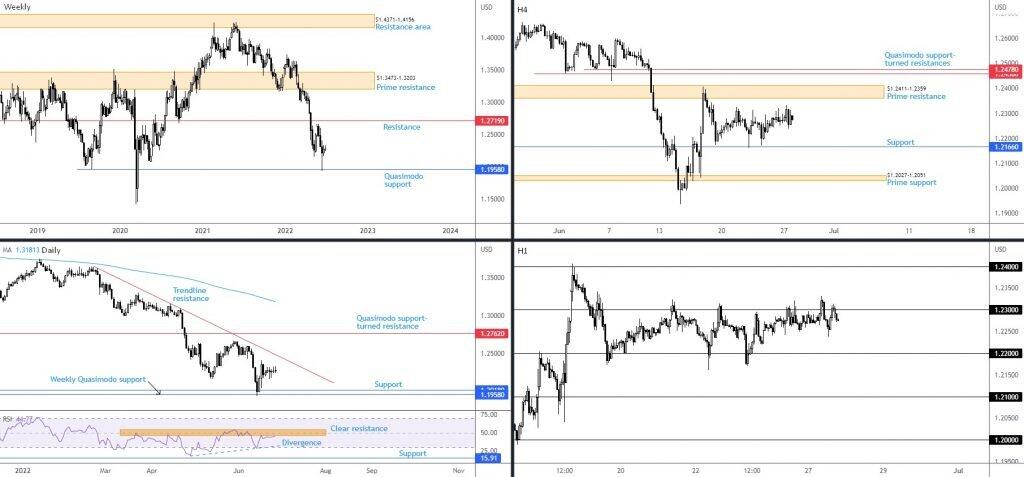EUR/USD:
Monday welcomed reasonably upbeat data out of the US; durable goods orders increased 0.7 per cent, versus the market consensus of 0.1 per cent. The US dollar immediately witnessed a bid against its major peers (US Dollar Index), though the move was short-lived and topped around 104.21 to finish the session lower. EUR/USD, therefore, pursued higher levels, tackling space north of the widely watched $1.06 figure (H1). Although sellers could make a show from this psychological number, H4 prime resistance at $1.0655-1.0632 remains strategically positioned above to facilitate a ‘deeper’ stop-run (a setup that could encourage a bearish phase).
Higher up on the curve, weekly support is still in the spotlight between $1.0298-1.0445, made up of a Quasimodo resistance-turned support at $1.0298, 2nd January low at $1.0340 (2017), and a 100% Fibonacci projection at $1.0445 (AB=CD harmonic bullish formation). As you can see, price has been bid from this area since early May. However, weekly Quasimodo support-turned resistance from $1.0778 capped buyers in early June, in a market reflecting a primary bear trend since 2021. Adding to this, seen from the monthly timeframe, the vibe has been to the downside since topping in April 2008. The trend, as noted in recent writing, is likely one of the main factors discouraging any meaningful buying from current weekly support.
Technical Expectation:
Outlook largely unchanged from previous analysis.
A higher run on stops above $1.06 may draw a fakeout to H4 prime resistance nearby at $1.0655-1.0632. For the most part, a $1.06 whipsaw on the H1 might be considered a bearish play, as sellers (in line with the overall trend) may enter from $1.0655-1.0632, attempting to fade buy-stop momentum.
Nevertheless, traders are encouraged to also remain aware that the EUR/USD is currently bid from higher timeframe support, in spite of a decisive downtrend.
AUD/USD:
AUD/USD performance was limited on Monday, ranging between $0.6959 and $0.6907. Overall, technically speaking, I remain bearish in the medium term. The rationale behind this falls largely on the back of trend direction. Here is what I noted in Monday’s weekly technical briefing:
The monthly timeframe has portrayed a downtrend since August 2011, indicating the rally from the pandemic low of $0.5506 (March 2020) to a high of $0.8007 (February 2021) on the weekly timeframe is likely viewed as a deep pullback among long-term chartists. Downside from the 2021 February top (an early primary bear trend), therefore, is potentially seen as a move to explore lower over the coming weeks.
On top of this, the weekly timeframe demonstrates scope to explore lower levels until reaching support between $0.6632 and $0.6764 on the bigger picture, composed of a 100% Fibonacci projection, a price support, and a 50% retracement. Furthermore, we remain south of the 200-day simple moving average on the daily timeframe at $0.7229, together with daily Quasimodo support from $0.6901 threatening to give way and the relative strength index (RSI) set beneath its 50.00 centreline (negative momentum). Note that $0.6901 has failed to motivate buying since mid-June.
Against the backdrop of higher timeframe action, H1 resistance demands attention at 0.6960, while continuation buying unearths H1 prime resistance at $0.7029-0.6984 (set beneath H4 prime resistance at $0.7062-0.7031) and, of course, the widely watched $0.70 figure established within. Downstream, though, points the finger to $0.69 and a familiar H1 prime support at $0.6863-0.6892.
Technical Expectation:
Similar outlook to Monday’s report:
Given psychological values are prone to whipsaws, particularly big figures like $0.70, a run above the number could play out if we retest H1 prime resistance at $0.7029-0.6984, which may trigger bearish flow. However, do bear in mind that circling just above the H1 zone is H4 prime resistance drawn from $0.7062-0.7031, indicating a whipsaw of $0.7029-0.6984 is also possible.
Both setups are considered bearish, in line with the overall downtrend.
USD/JPY:
USD/JPY modestly scaled higher on Monday, braced amid rising US Treasury yields and a risk-off mood. In spite of yesterday’s bid, the technical picture remains mostly unchanged and will, therefore, reflect thoughts echoed in Monday’s weekly technical briefing.
Despite the USD/JPY touching highs at ¥136.71 (levels not seen since 1998), in a market decisively trending higher since 2021, momentum noticeably slowed in recent trading. Last week’s action printed a half-hearted shooting star (bearish) candlestick pattern from weekly resistance, made up between ¥137.23 and ¥136.04. Support, for those looking lower, remains obvious at ¥125.54 (tucked under the ¥126.36 swing low [24th May]).
Supply-turned demand at ¥131.93-131.10 on the daily chart merits consideration as price responded from the zone in mid-June. While current weekly resistances are on my immediate radar, the daily timeframe throws up another resistance alternative just above the weekly lines at ¥139.55, a Quasimodo support-turned resistance.
The current weekly resistances also remain the main focus on the H4. After a dip from the weekly resistance zone, a H4 decision point from ¥134.49-135.43 greeted price and appears to be holding ground.
Technical Expectation:
Having seen H1 price reclaim ¥135+ status, together with room to climb on the daily timeframe (to ¥139.55) in a market clearly trending northbound, buyers may still be in the driving seat. While price has struggled to find grip around ¥135, current efforts to hold the number might prove sufficient for buyers to take aim at ¥136.
GBP/USD:
Sterling wrapped up Monday off best levels against the US dollar, relinquishing the majority of earlier gains from $1.23 amid US hours. Note that $1.23 has served well as short-term resistance since 21st June; still, conviction (from sellers) appears fatigued and implies $1.23 is likely to step aside in upcoming trade, a move exposing $1.24. Interestingly, though, should a $1.23 breach unfold, breakout buyers are encouraged to pencil in H4 prime resistance at $1.2411-1.2359 as this area, albeit having its range tested (may have weakened the zone), could still cap buying.
Across the page, weekly Quasimodo support at $1.1958 remains in the picture. Though upside momentum diminished last week, the $1.1958 response could drum up sufficient backing to reach trendline resistance on the daily timeframe, taken from the high $1.3639. A bearish reaction from the trendline resistance is supported by the trend. I noted the following in regards to current trend and also the relative strength index (RSI) in recent writing:
Trend direction in this market is unmistakably bearish, fashioning a series of lower lows/highs since February/May’s double-top formation at around $1.4241. Furthermore, seen through the monthly timeframe, the long-term downtrend has actually been soft since late 2007 tops at $2.1161.
We can see the RSI is testing resistance around the 50.00 centreline, following positive divergence. Voyaging above 50.00 is a sign of positive momentum and could push for a test of the noted trendline resistance.
Technical Expectation:
Given the lacklustre performance on Monday, the technical outlook is unchanged for the time being:
The reaction from weekly Quasimodo support at $1.1958 may encourage buying to draw price towards daily trendline resistance. It is here that sellers may decide to put on a show, in keeping with the overall downtrend. This translates to a possible $1.23 breach to the upside in the short term (H1), and possible rally to at least $1.24ish.
This material on this website is intended for illustrative purposes and general information only. It does not constitute financial advice nor does it take into account your investment objectives, financial situation or particular needs. Commission, interest, platform fees, dividends, variation margin and other fees and charges may apply to financial products or services available from FP Markets. The information in this website has been prepared without taking into account your personal objectives, financial situation or needs. You should consider the information in light of your objectives, financial situation and needs before making any decision about whether to acquire or dispose of any financial product. Contracts for Difference (CFDs) are derivatives and can be risky; losses can exceed your initial payment and you must be able to meet all margin calls as soon as they are made. When trading CFDs you do not own or have any rights to the CFDs underlying assets.
FP Markets recommends that you seek independent advice from an appropriately qualified person before deciding to invest in or dispose of a derivative. A Product Disclosure Statement for each of the financial products is available from FP Markets can be obtained either from this website or on request from our offices and should be considered before entering into transactions with us. First Prudential Markets Pty Ltd (ABN 16 112 600 281, AFS Licence No. 286354).
Recommended Content
Editors’ Picks
EUR/USD holds above 1.0700 ahead of key US data

EUR/USD trades in a tight range above 1.0700 in the early European session on Friday. The US Dollar struggles to gather strength ahead of key PCE Price Index data, the Fed's preferred gauge of inflation, and helps the pair hold its ground.
USD/JPY stays above 156.00 after BoJ Governor Ueda's comments

USD/JPY holds above 156.00 after surging above this level with the initial reaction to the Bank of Japan's decision to leave the policy settings unchanged. BoJ Governor said weak Yen was not impacting prices but added that they will watch FX developments closely.
Gold price oscillates in a range as the focus remains glued to the US PCE Price Index

Gold price struggles to attract any meaningful buyers amid the emergence of fresh USD buying. Bets that the Fed will keep rates higher for longer amid sticky inflation help revive the USD demand.
Sei Price Prediction: SEI is in the zone of interest after a 10% leap

Sei price has been in recovery mode for almost ten days now, following a fall of almost 65% beginning in mid-March. While the SEI bulls continue to show strength, the uptrend could prove premature as massive bearish sentiment hovers above the altcoin’s price.
US core PCE inflation set to signal firm price pressures as markets delay Federal Reserve rate cut bets

The core PCE Price Index, which excludes volatile food and energy prices, is seen as the more influential measure of inflation in terms of Fed positioning. The index is forecast to rise 0.3% on a monthly basis in March, matching February’s increase.



